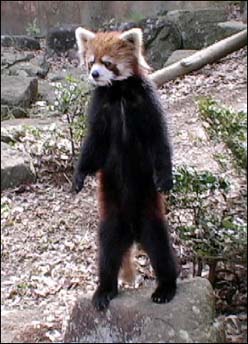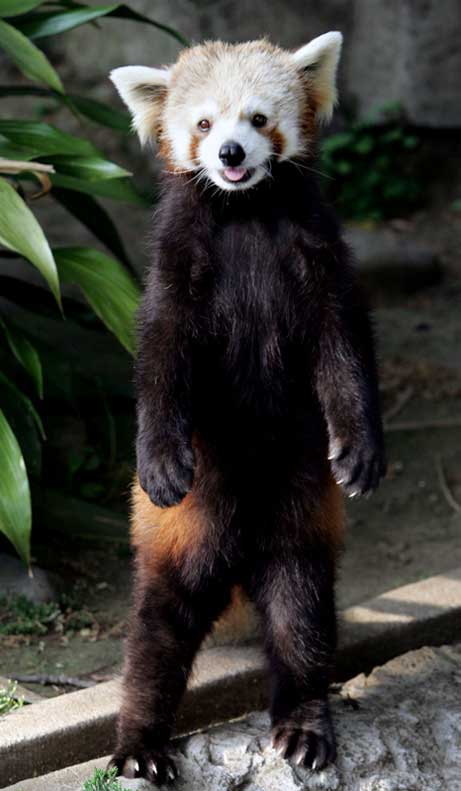Red Panda Discovery Exclusive
Posted by: Loren Coleman on August 9th, 2010

AOL News published their red panda fossil discovery article, based on Cryptomundo’s initial exclusive of the story.
Please see it here.

East Tennessee State Univ. Photo Lab
East Tennessee State University paleontologist Steven Wallace holds the skulls of a red panda fossil (left) and a modern red panda (right) on March 14, 2008.

As AOL reports: “News of the most recent red panda fossil skull was first reported on the Cryptomundo website by Loren Coleman, director of the International Cryptozoology Museum in Portland, Maine.”
Coleman visited the Gray Fossil Site about a week ago and was told of the discovery of a new red panda skull.
“They showed us different pits where they were digging for a crocodile, a rhino, tapirs and this one where they found the red panda,” he said.
Courtesy of Steven Wallace
Wallace holds a baby red panda during a panda workshop hosted by the Knoxville Zoo in Tennessee on Aug. 17, 2008.
Lee Speigel ends the article, thusly:
“I think it’s groundbreaking because a lot of these animals are known from one area of the world. If all of a sudden they’re found in North America, it gives cryptozoologists a lot of hope that many of these species that we project as mostly Asian actually have a connection between the continents. One thing that I think people often forget is that, in cryptozoology, while a lot of people think there may be brand-new species, cryptozoologists are realistic [and] know that some of these [future discoveries of cryptids] may be relic survivors.”
But how exactly do we know if a 4½ million-year-old red panda was, well, red? Does Wallace and his team of paleontologists really know the color of the panda they just dug up?
“We don’t know it’s red. I’ve chosen to use the term red panda, rather than ‘lesser’ panda, because some people who work on red pandas get insulted if you call it a lesser panda.
“They feel that it’s not like it’s less important than a giant panda. They prefer to call it a red panda, so that’s the only reason I use that term — ours could have been any color.”
At 37, Wallace has many years of fossil discoveries ahead.
“Yeah, I like to tell people that I’ll retire long before we’re finished out here. The site is so big, I figure I’ll dig for the next few decades, and when I retire, they’ll still be digging here.
“We have this huge list of animals that we’ve already found, but the list of animals that we could find is just as big, and then, there’s always the surprises — I mean, I did not expect to find a panda or a Eurasian badger here. Who knows how many other surprises we’ll get out here.”
Coleman agrees this can only ultimately benefit science.
“I think for science and paleontology, finding another red panda in North America makes us aware that if they’ve only uncovered 1 percent of the animals at the site, what are they going to find when they keep digging? It’s quite exciting — they could have a whole range of new animals there.”
For the entire article, click here.

About Loren Coleman
Loren Coleman is one of the world’s leading cryptozoologists, some say “the” leading living cryptozoologist. Certainly, he is acknowledged as the current living American researcher and writer who has most popularized cryptozoology in the late 20th and early 21st centuries.
Starting his fieldwork and investigations in 1960, after traveling and trekking extensively in pursuit of cryptozoological mysteries, Coleman began writing to share his experiences in 1969. An honorary member of Ivan T. Sanderson’s Society for the Investigation of the Unexplained in the 1970s, Coleman has been bestowed with similar honorary memberships of the North Idaho College Cryptozoology Club in 1983, and in subsequent years, that of the British Columbia Scientific Cryptozoology Club, CryptoSafari International, and other international organizations. He was also a Life Member and Benefactor of the International Society of Cryptozoology (now-defunct).
Loren Coleman’s daily blog, as a member of the Cryptomundo Team, served as an ongoing avenue of communication for the ever-growing body of cryptozoo news from 2005 through 2013. He returned as an infrequent contributor beginning Halloween week of 2015.
Coleman is the founder in 2003, and current director of the International Cryptozoology Museum in Portland, Maine.










Red pandas are some gorgeous creatures. I had the pleasure of seeing one up close a year or so ago when the Birmingham Zoo had one on exhibit for a short while. I spent a good hour at that enclosure admiring it.
Tell Wallace he is not allowed to retire until he finds me a full skeleton of a Gigantopithecus! 😉